AnimeNEXT 2013: Panel Reports
History, Obscurities, and Alcohol!
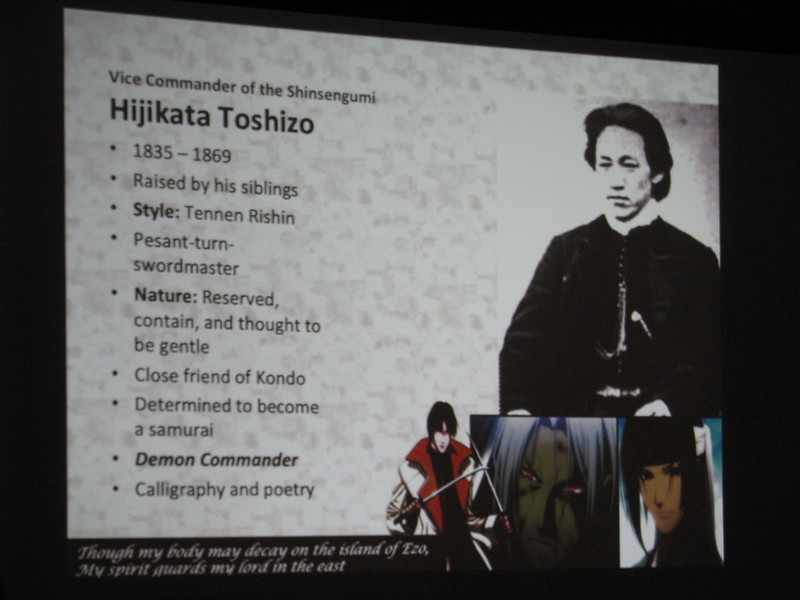 Ink and Evan went to a bunch of panels at AnimeNEXT 2013, and brought back loads of impressions from the New Jersey anime convention. Check them all out after the break and look out for them at your local con!
Ink and Evan went to a bunch of panels at AnimeNEXT 2013, and brought back loads of impressions from the New Jersey anime convention. Check them all out after the break and look out for them at your local con!
Samurai Stereotypes in Historical Fiction Anime and Manga
One of the reasons I love attending panels is the plethora of information fans make available, abating some section of my broad ignorance with their pointed passion. This panel, perhaps more so than any other this AnimeNEXT, epitomized that concept. The two panelists acted as a modular team: one explained historical details and context of a particular era, and the other filled in details on specific figures from that period. The formula was a great one; anecdotes and interesting stories peppered throughout the history lesson kept the pace lively, and the connections to anime and manga made the content feel perfectly integrated. Also worth noting, the Fact vs. Myth segment later in the panel was good, interactive way to regain any attentions that may have wandered during the presentation at that point. The most amazing occurrence during this panel, however, was that an audience member actually asked when a good time to bring up supplementary info would be — truly a demonstration of thoughtfulness. The panelists, however, should have cut him off a little sooner than they did, as he soon started to speak at length and detracted from the presentation. The same person also interjected again later, this time without asking. Give ‘em an inch… –Ink
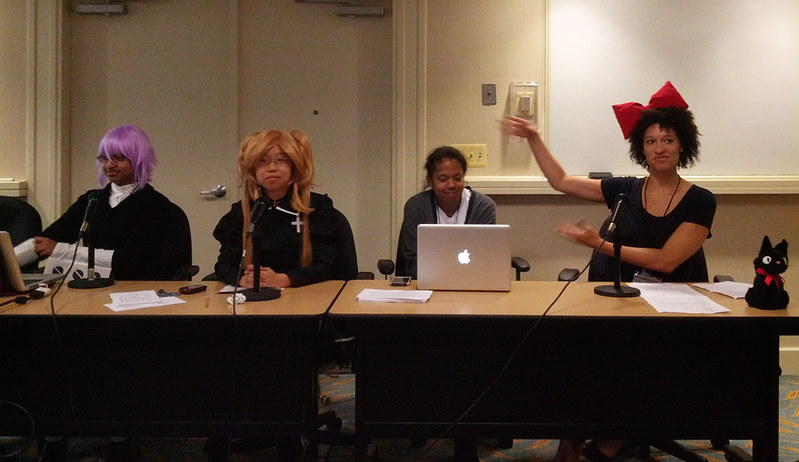
Female Stereotypes in Shojo and Josei Manga
I’m always happy to indulge in a little bit of fandom academicism, so early in the day on Friday I found myself at “Female Stereotypes in Shojo and Josei Manga,” run by four young women with what seemed to be a variety of academic backgrounds and anime preferences. The panel was split into four parts, one for each host, and they generally focused more on evolution and comparison of archetypes in shojo, rather than pointing out stereotypes and why they’re problematic. In a way this was kind of refreshing, since I was expecting an angry panel and instead got a thought-provoking look at women’s issues through discussions of life goals in Paradise Kiss, androgyny in Ouran High School Host Club, and working mothers in Sailor Moon. Since I’m not a big shojo reader, I couldn’t speak to the accuracy of their assessments, but the hosts managed to keep things interesting and educational even for someone without a personal connection to the series on display. –Evan
Directing an Anime
Given that there was an actual anime director present at this con, the fact that this panel was run by a fan made it all the more tempting to attend. Car crash rubberneckers; everyone loves to search twisted metal in hopes of glimpsing bodies. Armed with a couple film classes and a modicum of field work under his belt, the panelist (who, in fact, has never directed an anime) ran the audience through the general process of directing a film. Explanations of script lining, shot lists, floor plans, framing techniques, storyboarding, etc. were all pertinent, but something felt lacking. There was also a clumsy bit where a volunteer was called upon to demonstrate camera angles, because, you know, nothing represents how to direct a 2D production than two 3D people moving around in front of the room subject to multiple perspectives. Examples of what the panelist thought were exceptionally good or bad were lacking context in most instances, the discussion often devolved into fan rants, and the application to anime was weak at best. Some of the presenter’s material was pertinent, but the framing of this panel would need to change in order to work, something like directorial techniques in anime, with much better examples and research. –Ink

Anime Pilots and Precursors
Presented by George Horvath of The Land of Obscusion, “Pilots & Precursors” is just as it sounds — a panel about the productions that paved the way for their more famous successors. The panel took the form of a clipshow, with an introduction followed by a video for each title. Unfortunately, George’s Shonen Jump expertise meant that the panel exclusively relied on titles from Weekly Shonen Jump, which made it a little repetitive. Still, seeing stuff like the 1998 Yu-Gi-Oh! series (no magical trading card game to be seen), a short-lived anime adaptation of Seikimatsu Leader den Takeshi! from Toriko creator Mitsutoshi Shimabukuro (the manga was cancelled when the author was arrested for child prostitution), and the JoJo’s Bizarre Adventure movie (so bad Araki won’t let its Japanese dub be shown anywhere) was pretty cool. George is particularly good at bridging the difficult gap between the obscure and the mainstream with both his choices of titles and his presentation style. Now if he can just shorten his clips and fit in some more non-Shonen Jump stuff — might I suggest the Dirty Pair’s first animated appearance in Crusher Joe: The Movie? — he’ll have a truly eye-opening panel on his hands. –Evan
The Beautiful Backgrounds of Anime
Put together by Ani-Gamers’ own Evan Minto, this panel ran through background art chronologically via stills that exemplified changes in technique, focus, and influence. I might never look at a scene the same way again. In fact, after listening to Minto explain moving backgrounds, multi-plane projection, perspective distortion, scene layout/planning, and the like, I began to take notice of these aspects in the media shown in other panels throughout the day. Evan’s choices of backgrounds elicited gasps of awe on more than a few occasions, but I did find myself thinking that some of the examples, particularly early on, needed more concrete explanation. The word “detailed” was thrown around a lot, but specific examples were few and far between…until we got to Shinkai. “Let’s just take a second and look at that,” said Minto looking at a shot from 5 Centimeters Per Second. And really, that’s all that needs to be said about Shinkai, a master of visual storytelling. Here’s where Minto starting pointing out attention to detail via specifics, and examples thereafter benefitted from the same (to varying degrees). If this panel focused on one creator or one particular work, it could’ve well been a DVD commentary track, and I ain’t just sayin’ that ‘cause he’s my boss. –Ink
Horrible Anime by Great Directors
“That’s right, we’re starting this off by killing a puppy,” said Mike Toole after rolling a clip from Maetel Legend. The content of the chosen shows and Toole’s humorous riffs on the selected scenes made for entertainment at its finest. In all, Toole showcased one anime each from 10 directors. With roughly 6 minutes to spend on each example of horrible anime, there was time enough to show a couple scenes which represented how detestable the work at hand was with some color commentary interspersed between for perspective. But for as fun a panel as this was, it’ll forever be remembered as heckler smackdown 101. Someone in the audience decided to make like the MST3K crew, shouting out lame and unfunny comments about the material on screen. After only a few such remarks, Toole stopped everything, faced dead-center, and said something to the tune of “Sir, you are so dense with unfunny that funny bends around you.” After that, not a peep came from that guy for the rest of the panel. –Ink

Sake Tasting Panel
I’ve been trying to attend this for as many years as I’ve been attending AnimeNEXT. Competition is fierce! You have to a) be 21 or older, b) sign up early to be one of the 20 people trusted with the secret location of the room, and c) have the $10 to “tip” the guy at the door. It was fortuitous that I’d just written a Drunken Otaku concerning Oishinbo’s Sake volume. The information gleaned from its pages enabled me to answer most of the questions posed by generous hosts Greg and Mike, who were very learned in the way of the drink and great fellas to talk with. The actual tasting was structured thus: a brief introduction was given explaining the nature of each particular sake, which was followed by a small, tasting size pour and everyone’s two cents on what they tasted, smelled, and felt. After each bottle was sampled, we were invited to polish off what remained . . . and there was a LOT. People got comfy, got to talking, got refills, and continued for a good hour before disbanding and wobbling about the rest of the con. This was a great way to taste (and indulge) in several high-end sake bands as well as learn some you wanna stay away from. –Ink

Anime Under the Radar
It could’ve just been a list and clip panel of favorite obscure works, but it was so much more. Bill Ellis had a full lineup prepared: Miyazaki’s Pippi Longstocking, Ai to Yuki no Pig Girl Tonde Burin, and Maeterlinck’s Blue Bird. There were clips, there were stills, but there was also some information on background and production as well as timeline and genre influence. And there were still three more panelists to go! Dylan Farrar followed, serving up a delicious summary of Chuka Ichiban (Cooking Master Boy) by Etsushi Ogawa and explained a little about its overlooked genre. Next, Elizabeth Ellis brought up the absolutely unheard of Attack on Titan . . . seriously — an anime so stealthy that there were several people cosplaying its characters AT THIS CON, so obscure that the series is only being subbed and simulcast LEGALLY by not one but TWO major distributors! The inappropriate choice aside (the ending animation director was also AT THIS CON), Elizabeth, with occasional assistance from Casey Schoenberger, at least dug into the anime to explore some of its themes and explain how it’s kind of an oddity. –Ink
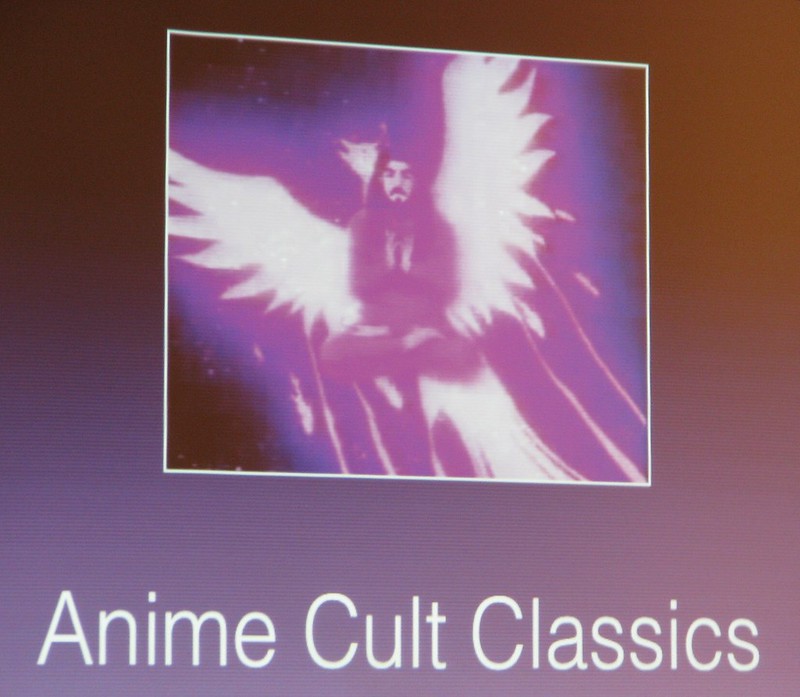
Anime Cult Classics
Technically, Mike Toole’s panel “Anime Cult Classics” isn’t a prank panel, but if you only read the title, you’re in for quite a surprise. That’s because the panel isn’t about anime that were under-appreciated upon release but gained a cult following thereafter — it’s about anime produced by cults! That’s right, series made by cults both harmless and creepy (Aum Shinrikyo, the cult behind the 1995 sarin gas attacks on the Tokyo subway, makes an appearance). Mike has a pretty predictable structure at this point, and Cult Classics was no exception. Introduce a funny clip, show the clip, provide some interesting historical background. Rinse, repeat. It’s simple, but I’ll be damned if it doesn’t work. The subject matter meant that the panel was entirely made up of things I had never heard of (I didn’t even know you could fill a panel with anime made by cults!), and the added information about each clip made it a bizarre and educational romp through some wacky Japanese religions. –Evan
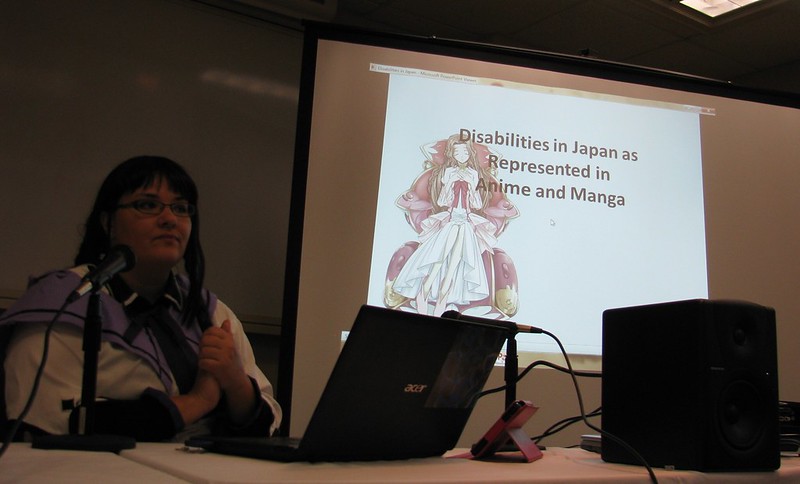
Disabilities in Anime and Manga
Like the Directing an Anime panel, this panel was led by a person with little formal (psychological) experience, but she did have a special-needs family member. To me, that kind of life-knowledge is worth a ton more when making a panel highlighting anime and manga featuring characters with physical and mental disabilities. To her credit, the panelist was thorough — perhaps overly so. But before I get to what I didn’t like, here’s what I enjoyed. First, it’s great that a panel like this exists; it helps bring attention to those works within the mediums we love that help bring attention to disabilities to foster society’s greater sympathy for those who actually suffer. A good deal of ground was covered in terms of what constituted a disability, how traits such as gender can be disabilities and subject to different prejudices, the fettishism thereof, and a laundry list of afflictions. But the latter is where this panel got off track via, and I should hardly be the one to throw stones here, over-analysis. After serious afflictions both mental and physical, the panelist went into template personality types — tsundere, kudere, dandere, etc — as disabilities and turned the focus away from the mediums to works that cater to mental disabilities of their consumers: lolicon and shotacon. This ended the panel on a weak note, whereas most of its content was well-organized, insightful, and even somewhat enlightening/surprising. –Ink

The Evolution of American Anime
OK, I’ll be honest. I only went to this panel because it looked bad. “American Anime”? C’mon, there’s no way this was going to turn out well. Man, I hate being right. “The Evolution of American Anime” began with the panelist haltingly describing his pet theory about animation, dubbed “The Walt Disney Theory of Animation Categorization,” and went on to describe how anime has evolved in both Japan and the U.S., switching back and forth between the countries without adequately explaining what he meant by “anime.” Seriously, this guy unironically said that Sleeping Beauty is both the missing link between the art styles of Astro Boy and Speed Racer (what?) and that the film is “anime” because it’s, uh, well animated. I guess. Eventually, he revealed the central problem with his entire panel: “As far as I see it, the difference between cartoons and anime is this. Cartoons are surreal, but anime is realistic.” When you’re working off of a fundamentally flawed definition like that (not to mention the baffling concept that anime is somehow “not cartoons”), it’s no wonder you’re going to spend half the panel telling everyone that Batman Beyond is “anime because it has such good writing and characterization.” It took every fiber of self-control in my body to stop myself from being the obnoxious guy correcting the panelist, and after the panel I struggled to come up with a polite way to tell him that his entire premise didn’t make sense. (I never did end up coming up with a tactful way to say it — sorry, guy!) –Evan
World War Two in Anime
Originally this panel was cancelled, and I was miffed. I’d heard great things about it from Charles Dunbar and was eager to check it out. Amazingly and to everyone’s benefit, panelist Haru Menna, despite having been in a car accident the previous day, went on to do the panel the following day! If it comes around again, I highly suggest seeing this one. Instead of just identifying anime which feature elements of WWII or use it as a backdrop, the panelist delved deeper to examine how, why, and to what effect such elements are used in various series, and he does so with great flare. No-one could accuse the presenter of having a dry delivery, but his enthusiasm-induced intensity could stand some toning down or self-regulation every now and again. Haru was downright animated — thoroughly knowledgeable of and engrossed in material he was delivering. The panel’s content was broken down into parts history, examination, and and analysis, a ratioed balance made smooth by Haru’s aforementioned flare and genuine excitement bordering on exuberance. The angles taken in his examination and analysis made me think a little differently about how I’ll watch anime featuring WWII elements in the future, and that’s the sign of a great panel indeed. –Ink
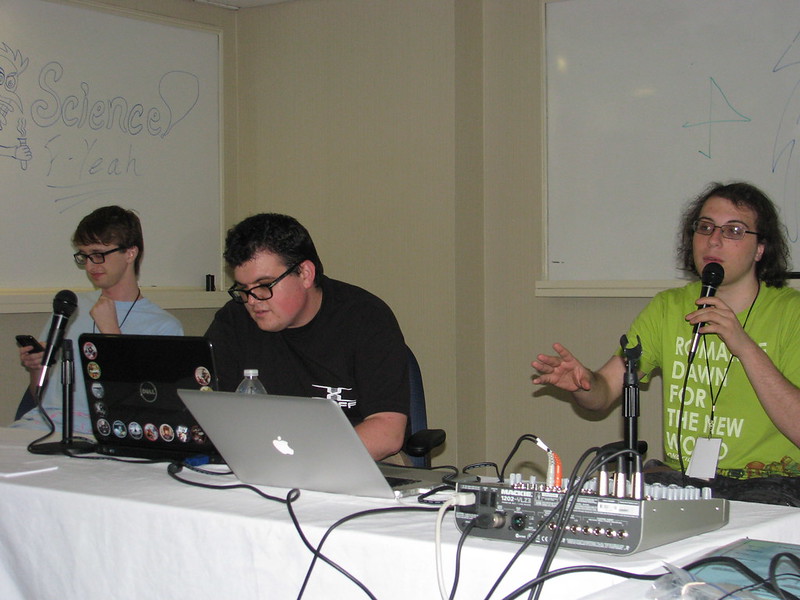
Panel Lightning Round
Five panelists and five presentations in 60 minutes. And … go! It’s an interesting concept (brainchild of Evan Minto) for a panel, one that would have probably gone a tad smoother if there were buffer times between room changes, but all in all things went pretty smoothly. A former Vertical intern, Chris, started things off by relaying ins and outs of his experiences there. Vinnie Averello followed up with a sampling of instances of classical music in anime. A bit exhausted and flustered from being harangued at some previous panels, Xan attempted to remember why he thought Macross: Do you Remember Love is worth remembering. Evan took over for a detailed Anime Production 101 runthrough, and Alain Mendez played the panel off in style by exposing musical references throughout JoJo’s Bizarre Adventure as soundtracked by those very same songs. I’d actually like to see this panel return. It seems a good teaser panel and a good way to test out panel ideas for future growth.
